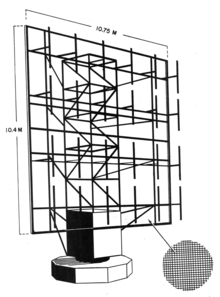Seetakt radar
 |
|
| Country of origin | Germany |
|---|---|
| Introduced | 1936 |
| Type | Naval surface search |
| Frequency | 368 MHz/81.5 cm |
| Range | 6–10 nautical miles (11–19 km; 6.9–11.5 mi) |
| Power | 7 kW |
The shipborne Seetakt radar was developed in the 1930s and was used by Nazi Germany's Kriegsmarine during World War II.
In Germany during the late 1920s, Hans Hollmann began working in the field of microwaves, which were to later become the basis of almost all radar systems. In 1935 he published Physics and Technique of Ultrashort Waves, which was picked up by researchers around the world. At the time he had been most interested in their use for communications, but he and his partner Hans-Karl von Willisen had also worked on radar-like systems.
In 1928 Hollmann, von Willisen and Paul-Günther Erbslöh started a company Gesellschaft für elektroakustische und mechanische Apparate (GEMA). In the autumn of 1934, GEMA built the first commercial radar system for detecting ships, similar to a system developed by Christian Hülsmeyer. Operating in the 50 cm range it could detect ships up to 10 km away. This early version of the system only provided a warning that a ship was in the general vicinity of the direction the antenna was pointed, it did not provide accurate direction or any sort of range information. The purpose was to provide an anti-collision system at night, in fog, and other times of limited visibility.
By order of the German navy, in the summer of 1935 they developed a pulse radar with which they could spot the cruiser Königsberg at a distance of 8 km, with an accuracy of up to 50 m, enough for gun-laying. The same system could also detect an aircraft at 500 m altitude at a distance of 28 km. The military implications were not lost this time around, and construction of land and sea-based versions took place as Freya radar and Seetakt. The navy's priority at that time was ranging. Detecting targets and obstacles by night or in bad weather were secondary objectives. Actually using it for gun laying, like the Würzburg radar developed for the German army, was initially not a priority for the Kriegsmarine.
The two systems were generally similar, although the early Seetakt systems worked on a 50 cm wavelength (600 MHz), while Freya was designed for much longer ranges and used a 2.5 m wavelength that could be generated at high power using existing electronics.
...
Wikipedia
